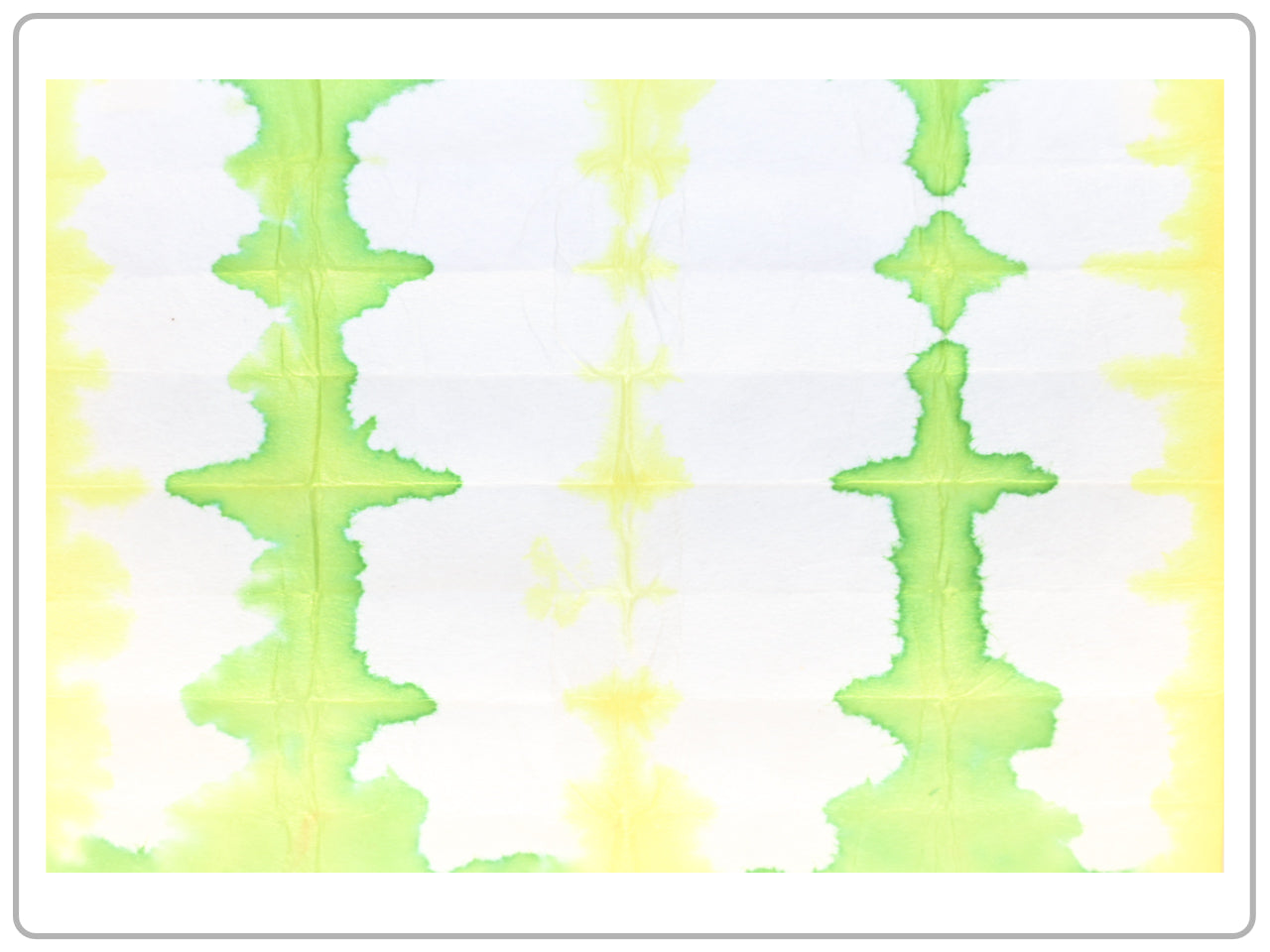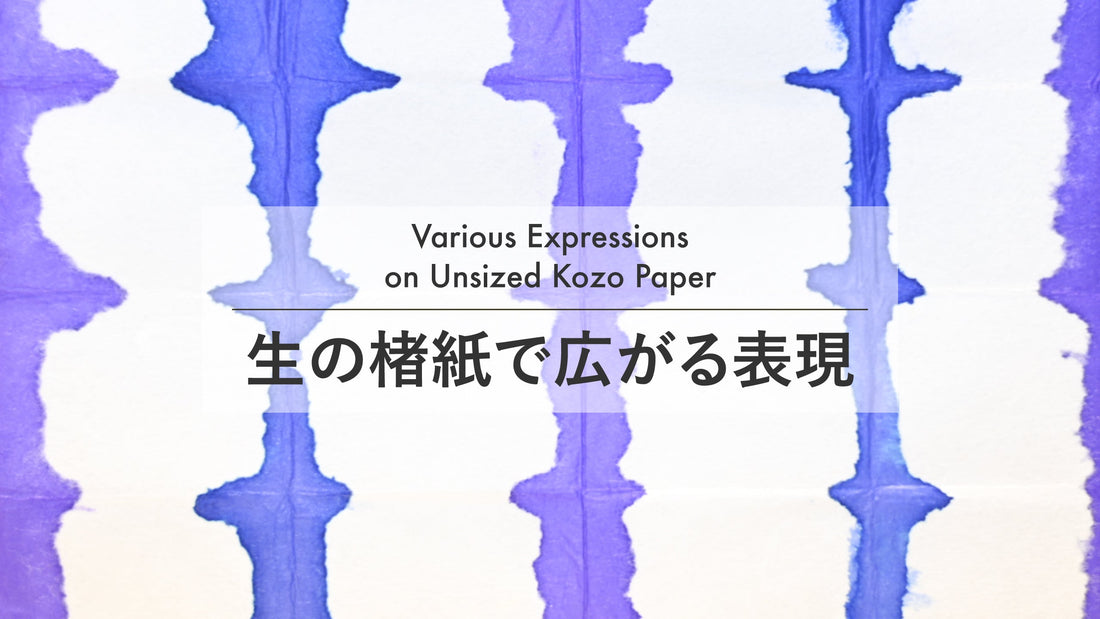The word "Washi" refers to paper that has been made in Japan for centuries.
Washi includes a wide variety of papers that are made of different raw materials and depending on the way to use it, different Washi paper creates different textures and expressions.
For example, the coloring can change dramatically depending on the pre-treatment, especially for preventing blotches.
This technique is called "Dosa sizing," by using a liquid mixture of animal glue and alum.
In PIGMENT TOKYO, we use the term "Dosa" for Washi paper that has been pre-treated and "Nama" for the one that has not.
In this article, we will use Kozo paper, which is easy for beginners to handle, and observe how the dosa affects the substrate through the coating samples.
First, let’s take a look at the following sample. I used water-based colorants such as color ink and watercolor paint to show how they spread on the Washi paper.

【Art Materials Used】
Color material: Color Ink
Substrate: Kozogami Mizarashi* 15 Monme (approx. 56.25g)
*Washi made from Kozo plant /paper mulberry without Dosa sizing

【Art Materials Used】
Color material: Color Ink
Substrate: Kozogami Mizarashi* with Dosa Sizing 15 Monme (approx. 56.25g)
*Washi made from Kozo plant /paper mulberry with Dosa sizing
I used a dropper to drop the color ink on the paper.
As you can see, the paper without Dosa sizing absorbs the ink immediately when the water drop hits the surface and it created a shape that reminded me of the image looking through a microscope.
On the other hand, ink was not absorbed right away and stayed on the sized paper for a while, and then the liquid dried while I was tilting and moving the paper.
There are parts of the ink bled, but also, there are some remaining marks of ink moved on the paper surface.
Next, I am going to try with watercolor.

【Art Materials Used】
Color material: Watercolor
Substrate: Kozogami Mizarashi* 15 Monme (approx. 56.25g)
*Washi made from Kozo plant /paper mulberry without Dosa sizing

【Art Materials Used】
Color material: Watercolor
Substrate: Kozogami Mizarashi* with Dosa Sizing 15 Monme (approx. 56.25g)
*Washi made from Kozo plant /paper mulberry with Dosa sizing
The watercolor ran out in the middle of the Washi paper without Dosa sizing even though I put a lot of paint on the brush. I also felt that the paper absorbed the paint too quickly and I found it difficult to control the paintbrush.
Moreover, when I applied some pressure to the Washi paper to draw thicker lines, all the paint was absorbed into it.
However, I was able to draw a thick straight line to the end of the Dosa sized-paper.
As you can tell from these four samples, although it is better to use unsized or raw paper for the expressions that let the color soak into the paper, there are actually more advantages of using raw papers other than this.
There are situations when you need to prepare a paper with stronger sizing, for example, when you use AQYLA paint which is made of alkyd resin, or water-based DUO oil paint on Washi paper.
For those cases, it would be best to adjust the percentage of Dosa sizing and apply it to the raw Washi paper by yourself.
As mentioned at the beginning of this article, a mixture of animal glue and alum is generally used for Dosa, but in PIGMENT TOKYO, we offer fish glue that can be used for Dosa sizing without alum to maintain the pH value of the paper in a more ideal condition.
This glue has high jelly strength, so it can be used even without alum to prevent blotting. For those of you who are interested in paper with excellent preservation properties, perhaps this is a perfect product to try out.
We also have Pig Glue for Sizing 20% solution, which is easy to use even for beginners.

【Art Materials Used】
Color material: Color Ink, DUO
Substrate: Kozogami Mizarashi* 15 Monme (approx. 56.25g) by applying with Fish Glue
*Washi made from Kozo plant /paper mulberry without Dosa sizing
By applying a slightly stronger Dosa than usual to the entire surface of the paper, you will be able to enjoy the brush strokes even with the slow-drying oil paints.
Although, the oil may cause damage to the paper if you apply it too much, therefore, it is better to control the percentage or amount of oil while using.
Other than that, you can also enjoy a simple wash-dyeing technique by soaking a folded Washi on a plate filled with colored water.
Wouldn’t it be fun to try this at home with your children to discover color in a more intuitive way?

【Art Materials Used】
Color material: Color Ink
Substrate: Kozogami Sarashi* (Bleached) 10 Monme (approx. 37.5g)
*Washi made from Kozo plant /paper mulberry without Dosa sizing

【Art Materials Used】
Color material: Color Ink
Substrate: Kozogami Sarashi* (Bleached) 10 Monme (approx. 37.5g)
*Washi made from Kozo plant /paper mulberry without Dosa sizing

【Art Materials Used】
Color material: Color Ink
Substrate: Kozogami Sarashi* (Bleached) 10 Monme (approx. 37.5g)
*Washi made from Kozo plant /paper mulberry without Dosa sizing
You can also apply the above method to create your own colored Washi paper.
If you use water-resistant colored ink, you can even draw on top of the paper, which opens the door for a wider range of expressions.

【Art Materials Used】
Color material: Color Ink
Substrate: Kozogami without Dosa sizing
I made a collage by arranging pieces of the papers I liked.
The contrast between smooth YUPO paper and stained Kozo paper was fascinating.

【Art Materials Used】
Color material: Color Ink
Substrate: YUPO Paper α, Kozogami without Dosa sizing
Even though they are the same type of Kozo paper, different materials create different textures depending on Dosa sizing.
I highly recommend the following article to those who want to know furthermore about Washi paper.
Last but not least, you can now purchase Washi papers through the link below.
Overseas shipping is also available as well as domestic delivery.
You are all invited to experience the charm of raw Washi paper!
Translated by Atsumi Okano and Nelson Hor Ee Herng
PIGMENT TOKYO Art Materials Experts












